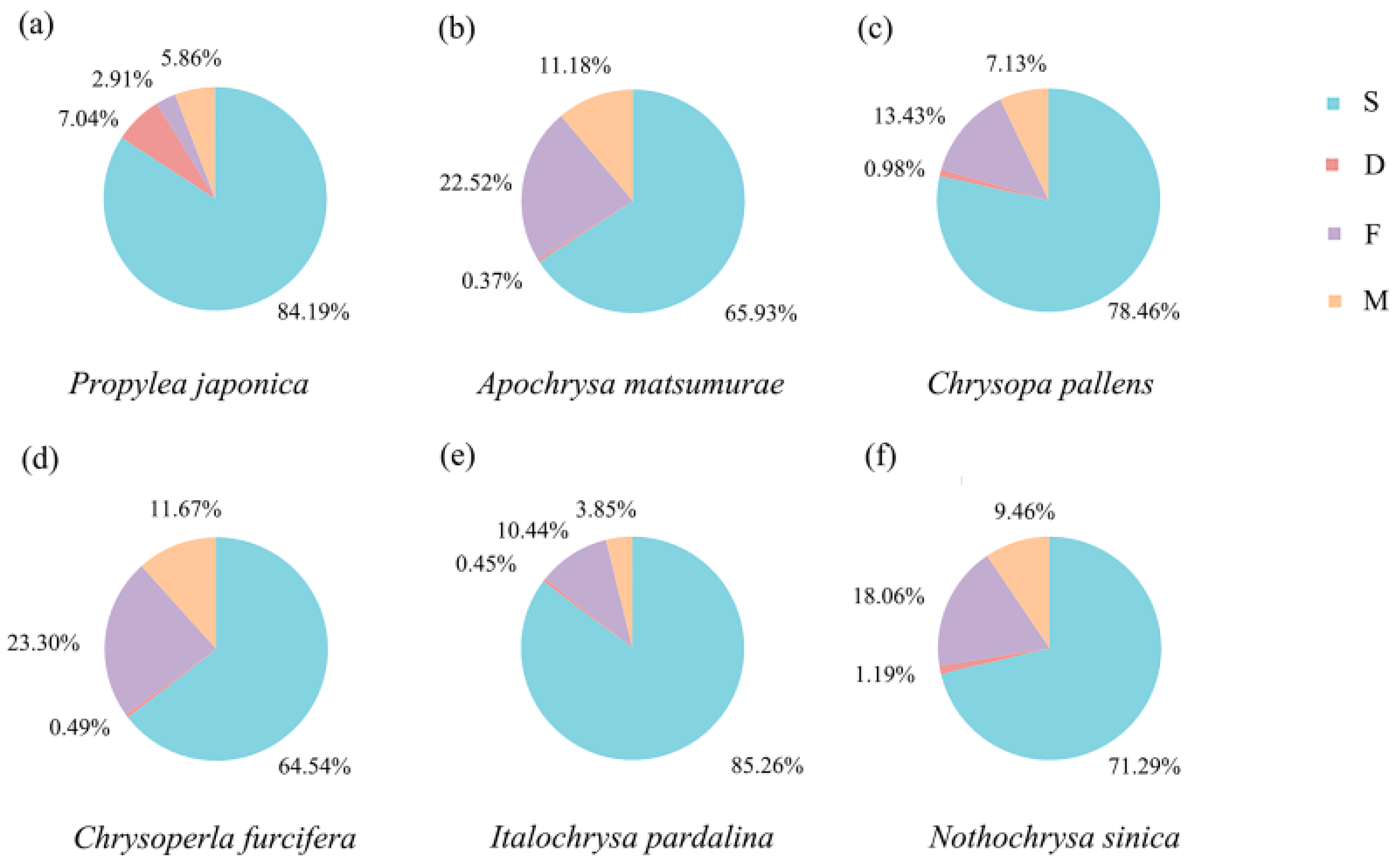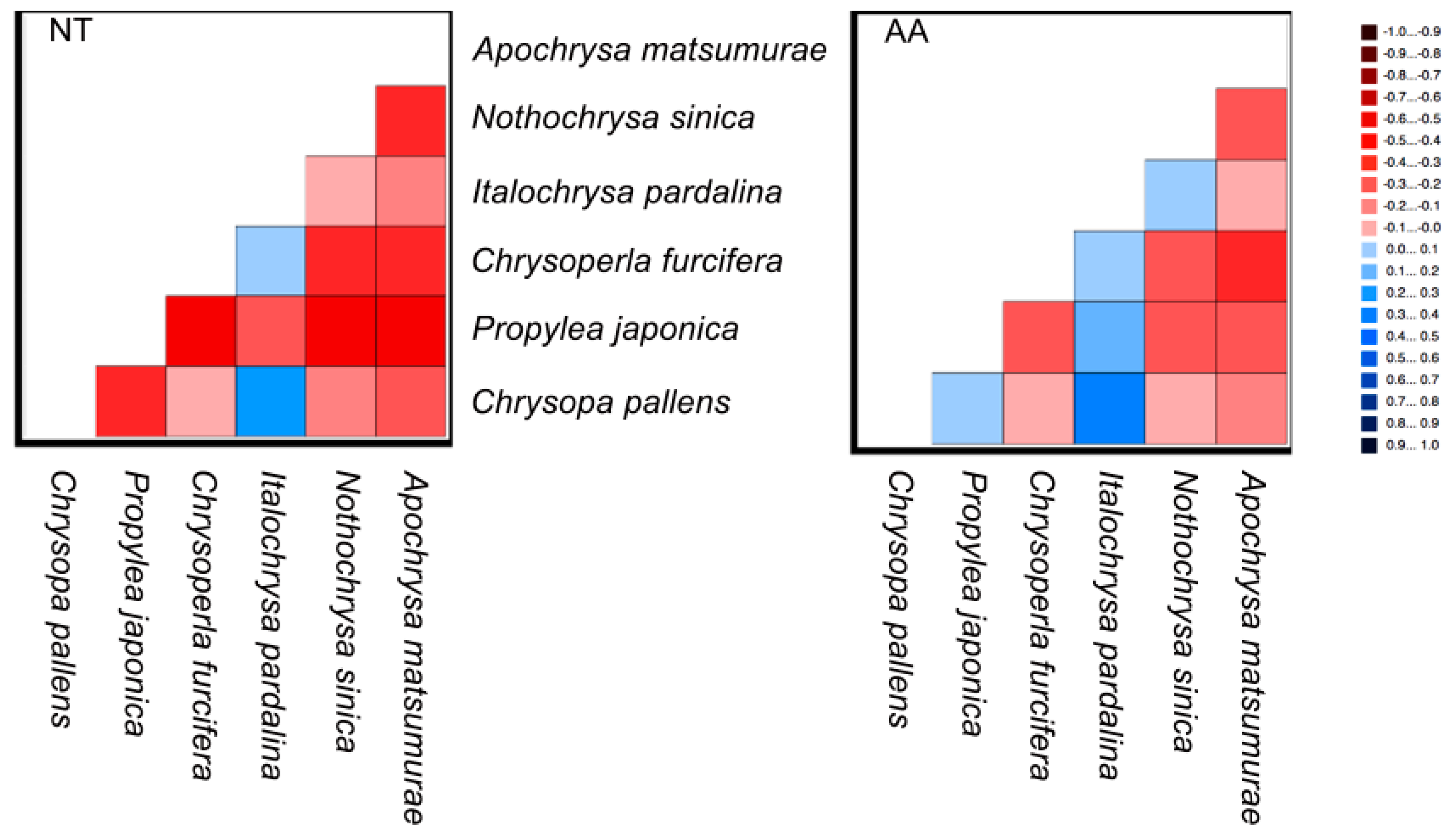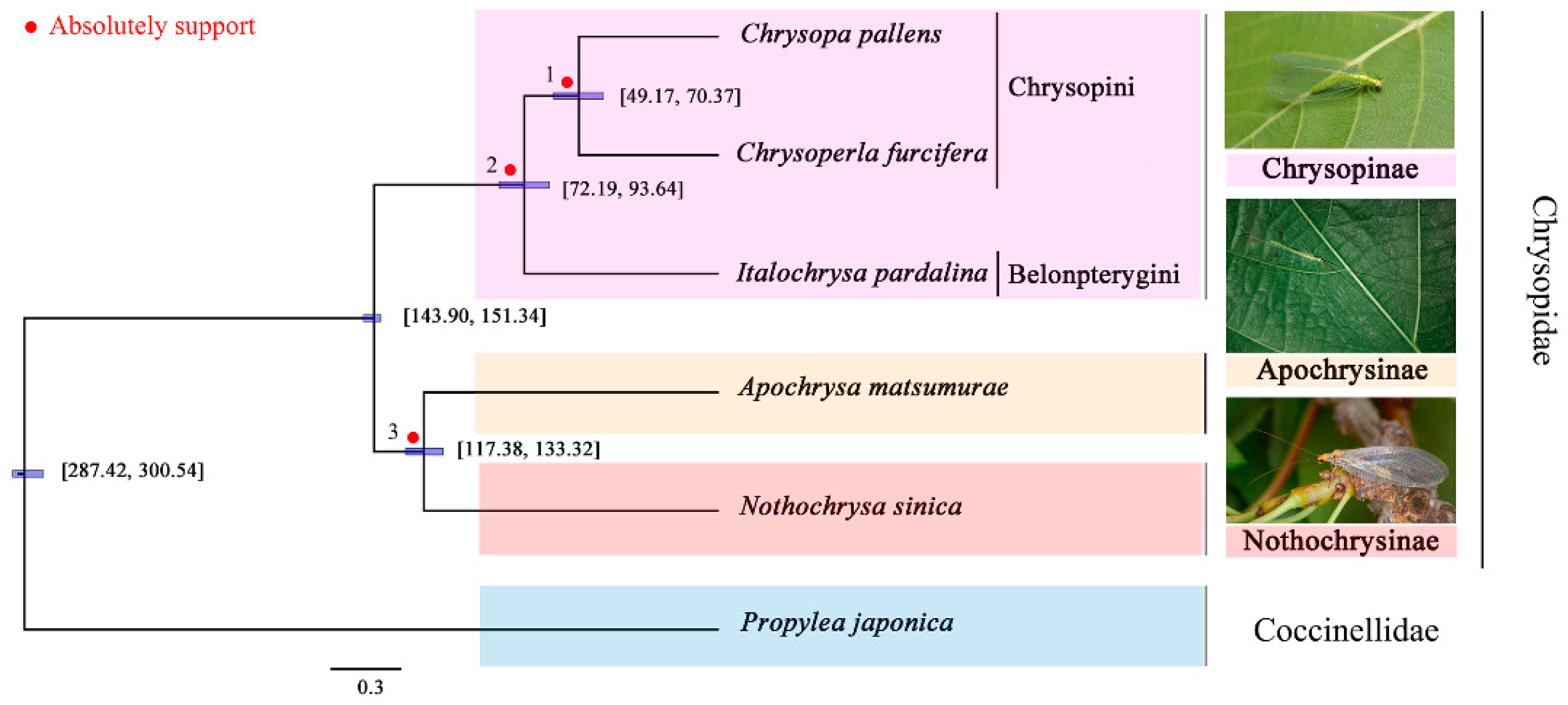Low-Coverage Whole Genomes Reveal the Higher Phylogeny of Green Lacewings
Abstract
Simple Summary
Abstract
1. Introduction
2. Materials and Methods
2.1. Insect Samples, DNA Extraction, and Sequencing
2.2. Genome Assembly
2.3. Gene Alignment and Data Matrix Construction
2.4. Heterogeneous Sequence Divergence Test
2.5. Phylogenetic Inference
2.6. Likelihood Mapping Analysis
2.7. Divergence Time Estimation
3. Results
3.1. Genome Assembly
3.2. Heterogeneous Sequence Divergence
3.3. Phylogenetic Analysis
3.4. Likelihood Mapping Analysis
3.5. Divergence Time Estimation
4. Discussion and Conclusions
Supplementary Materials
Author Contributions
Funding
Institutional Review Board Statement
Informed Consent Statement
Data Availability Statement
Acknowledgments
Conflicts of Interest
References
- Oswald, J.D. Lacewing Digital Library. Available online: http://lacewing.tamu.edu/ (accessed on 24 December 2020).
- Tsukaguchi, S.; Tago, T. Kuwayamachrysa, a new genus of lacewings (Insecta, Neuroptera, Chrysopidae, Chrysopinae, Chrysopini) with markedly divergent adult and larval features. Bull. Natl. Mus. Nat. Sci. 2018, 44, 69–85. [Google Scholar]
- Brooks, S.J.; Barnard, P.C. The green lacewings of the world: A generic review (Neuroptera: Chrysopidae). Bull. Br. Mus. Nat. Hist. Entomol. 1990, 59, 117–286. [Google Scholar]
- Senior, L.J.; McEwen, P.K. The use of lacewings in biological control. In Lacewings in the Crop Environment; McEwan, P.K., New, T.R., Whittington, A.E., Eds.; Cambridge University Press: Cambridge, UK, 2001; pp. 296–302. [Google Scholar]
- Duelli, P. Lacewings in field crops. In Lacewings in the Crop Environment; McEwen, P.K., New, T.R., Whittington, A.E., Eds.; Cambridge University Press: Cambridge, UK, 2001; pp. 157–171. [Google Scholar]
- Tauber, C.A.; Tauber, M.J.; Albuquerque, G.S. Plesiochrysa brasiliensis (Neuroptera: Chrysopidae): Larval stages, biology, and taxonomic relationships. Ann. Entomol. Soc. Am. 2001, 94, 858–865. [Google Scholar] [CrossRef][Green Version]
- Eisner, T.; Hicks, K.; Eisner, M.; Robson, D.S. “Wolf-in-sheep’s-clothing” strategy of a predaceous insect larva. Science 1978, 199, 790–794. [Google Scholar] [CrossRef] [PubMed]
- Tauber, C.A.; Tauber, M.J.; Albuquerque, G.S. Debris-carrying in larval Chrysopidae: Unraveling its evolutionary history. Ann. Entomol. Soc. Am. 2014, 107, 295–314. [Google Scholar] [CrossRef]
- Perez-de la Fuente, R.; Delclos, X.; Penalver, E.; Speranza, M.; Wierzchos, J.; Ascaso, C.; Engel, M.S. Early evolution and ecology of camouflage in insects. Proc. Natl. Acad. Sci. USA 2012, 109, 21414–21419. [Google Scholar] [CrossRef]
- Liu, X.Y.; Zhang, W.W.; Winterton, S.L.; Breitkreuz, L.C.V.; Engel, M.S. Early morphological specialization for insect-spider associations in Mesozoic lacewings. Curr. Biol. 2016, 26, 1590–1594. [Google Scholar] [CrossRef]
- Wang, B.; Xia, F.Y.; Engel, M.S.; Perrichot, V.; Shi, G.L.; Zhang, H.C.; Chen, J.; Jarzembowski, E.A.; Wappler, T.; Rust, J. Debris-carrying camouflage among diverse lineages of Cretaceous insects. Sci. Adv. 2016, 2, e1501918. [Google Scholar] [CrossRef] [PubMed]
- Brooks, S.J. An overview of the current status of Chrysopidae (Neuroptera) systematics. Deut. Entomol. Z. 1997, 44, 267–275. [Google Scholar] [CrossRef]
- Garzón-Orduña, I.J.; Winterton, S.L.; Jiang, Y.L.; Breitkreuz, L.C.V.; Duelli, P.; Engel, M.S.; Penny, N.D.; Tauber, C.A.; Mochizuki, A.; Liu, X.Y. Evolution of green lacewings (Neuroptera: Chrysopidae): A molecular supermatrix approach. Syst. Entomol. 2019, 44, 499–513. [Google Scholar] [CrossRef]
- Adams, P.A.; Penny, N.D. Neuroptera of the amazon basin, Part 11a, introduction and chrysopini. Acta Amazon. 1987, 15, 413–479. [Google Scholar] [CrossRef][Green Version]
- Winterton, S.L.; Brooks, S.J. Review of the green lacewing genus Chrysacanthia Lacroix with a new species from Nigeria (Neuroptera, Chrysopidae). Zookeys 2015, 517, 71–81. [Google Scholar] [CrossRef][Green Version]
- Adams, P.A. A review of the Mesochrysinae and Nothochrysinae (Neuroptera: Chrysopidae). Bull. Mus. Comp. Zool. 1967, 135, 215–238. [Google Scholar]
- Adams, P.A.; Penny, N. New genera of Nothochrysinae from South America (Neuroptera: Chrysopidae). Pan-Pacific Entomol. 1992, 68, 216–221. [Google Scholar]
- Duelli, P.; Hölzel, H.; Mansell, M. Habitat and larvae of the enigmatic genus Kimochrysa Tjeder (Neuroptera: Chrysopidae) in South Africa. In Proceedings of the Tenth International Symposium on Neuropterology; Devetak, D., Lipovšek, S., Arnett, A.E., Eds.; University of Maribor: Maribor, Slovenia, 2010; pp. 153–158. [Google Scholar]
- Tauber, C.A.; Faulkner, D.K. Pimachrysa (Neuroptera: Chrysopidae: Nothochrysinae): Larval description and support for generic relationships. Psyche A J. Entomol. 2015, 2015, 1–19. [Google Scholar] [CrossRef]
- Nel, A.; Delclos, X.; Hutin, A. Mesozoic chrysopid-like Planipennia: A phylogenetic approach (Insecta: Neuroptera). Ann. Soc. Entomol. Fr. 2005, 41, 29–68. [Google Scholar] [CrossRef][Green Version]
- Archibald, S.B.; Makarkin, V.N.; Greenwood, D.R.; Gunnell, G.F. The red queen and court jester in green lacewing evolution: Bat predation and global climate change. Palaios 2014, 29, 185–191. [Google Scholar] [CrossRef]
- Winterton, S.L.; Brooks, S.J. Phylogeny of the Apochrysine green lacewings (Neuroptera: Chrysopidae: Apochrysinae). Ann. Entomol. Soc. Am. 2002, 95, 16–28. [Google Scholar] [CrossRef]
- Kimmins, D.E. XCVII.-A revision of the genera of the Apochrysinae (Fam. Chrysopidae). Ann. Mag. Nat. Hist. 2009, 5, 929–944. [Google Scholar] [CrossRef]
- Tjeder, B. Neuroptera-Planipennia. The lace-wings of Southern Africa. 5. family Chrysopidae. In South African Animal Life; Hanström, B., Brinck, P., Rudebec, G., Eds.; Swedish Natural Science Research Council: Stockholm, Sweden, 1966; Volume 12, pp. 228–534. [Google Scholar]
- Tauber, C.A. Larval characteristics and taxonomic position of the lacewing genus Suarius. Ann. Entomol. Soc. Am. 1975, 68, 695–700. [Google Scholar] [CrossRef]
- Winterton, S.L.; Gillung, J.P.; Garzón-Orduña, I.J.; Badano, D.; Breitkreuz, L.C.V.; Duelli, P.; Engel, M.S.; Liu, X.; Machado, R.J.P.; Mansell, M.; et al. Evolution of green lacewings (Neuroptera: Chrysopidae): An anchored phylogenomics approach. Syst. Entomol. 2019, 44, 514–526. [Google Scholar] [CrossRef]
- Dai, Y.T.; Winterton, S.L.; Garzón-Orduña, I.J.; Liang, F.Y.; Liu, X.Y. Mitochondrial phylogenomic analysis resolves the subfamily placement of enigmatic green lacewing genus Nothancyla (Neuroptera: Chrysopidae). Aust. Entomol. 2017, 56, 322–331. [Google Scholar] [CrossRef]
- Winterton, S.; de Freitas, S. Molecular phylogeny of the green lacewings (Neuroptera: Chrysopidae). Aust. J. Entomol. 2006, 45, 235–243. [Google Scholar] [CrossRef]
- Haruyama, N.; Mochizuki, A.; Duelli, P.; Naka, H.; Nomura, M. Green lacewing phylogeny, based on three nuclear genes (Chrysopidae, Neuroptera). Syst. Entomol. 2008, 33, 275–288. [Google Scholar] [CrossRef]
- Duelli, P.; Henry, C.S.; Mochizuki, A. The endemic Atlantochrysa atlantica (McLachlan) (Neuroptera: Chrysopidae) on Atlantic Islands: African or American origin? J. Nat. Hist. 2014, 48, 2595–2608. [Google Scholar] [CrossRef]
- Jiang, Y.; Garzón-Orduña, I.J.; Winterton, S.L.; Yang, F.; Liu, X. Phylogenetic relationships among tribes of the green lacewing subfamily Chrysopinae recovered based on mitochondrial phylogenomics. Sci. Rep. 2017, 7, 7218. [Google Scholar] [CrossRef][Green Version]
- Misof, B.; Liu, S.L.; Meusemann, K.; Peters, R.S.; Donath, A.; Mayer, C.; Frandsen, P.B.; Ware, J.; Flouri, T.; Beutel, R.G.; et al. Phylogenomics resolves the timing and pattern of insect evolution. Science 2014, 346, 763–767. [Google Scholar] [CrossRef]
- Hittinger, C.T.; Johnston, M.; Tossberg, J.T.; Rokas, A. Leveraging skewed transcript abundance by RNA-Seq to increase the genomic depth of the tree of life. Proc. Natl. Acad. Sci. USA 2010, 107, 1476–1481. [Google Scholar] [CrossRef]
- Peters, R.S.; Meusemann, K.; Petersen, M.; Mayer, C.; Wilbrandt, J.; Ziesmann, T.; Donath, A.; Kjer, K.M.; Aspock, U.; Aspock, H.; et al. The evolutionary history of holometabolous insects inferred from transcriptome-based phylogeny and comprehensive morphological data. BMC Evol. Biol. 2014, 14, 52. [Google Scholar] [CrossRef] [PubMed]
- Zhang, F.; Ding, Y.; Zhu, C.D.; Zhou, X.; Orr, M.C.; Scheu, S.; Luan, Y.X.; Matschiner, M. Phylogenomics from low-coverage whole-genome sequencing. Methods Ecol. Evol. 2019, 10, 507–517. [Google Scholar] [CrossRef]
- Zhong, B.J.; Liu, L.; Yan, Z.; Penny, D. Origin of land plants using the multispecies coalescent model. Trends Plant. Sci. 2013, 18, 492–495. [Google Scholar] [CrossRef] [PubMed]
- Song, S.; Liu, L.; Edwards, S.V.; Wu, S.Y. Resolving conflict in eutherian mammal phylogeny using phylogenomics and the multispecies coalescent model. Proc. Natl. Acad. Sci. USA 2012, 109, 14942–14947. [Google Scholar] [CrossRef] [PubMed]
- Mirarab, S.; Warnow, T. ASTRAL-II: Coalescent-based species tree estimation with many hundreds of taxa and thousands of genes. Bioinformatics 2015, 31, 44–52. [Google Scholar] [CrossRef]
- Lartillot, N.; Philippe, H. A Bayesian mixture model for across-site heterogeneities in the amino-acid replacement process. Mol. Biol. Evol. 2004, 21, 1095–1109. [Google Scholar] [CrossRef] [PubMed]
- Lartillot, N.; Philippe, H. Computing Bayes factors using thermodynamic integration. Syst. Biol. 2006, 55, 195–207. [Google Scholar] [CrossRef]
- Salichos, L.; Rokas, A. Inferring ancient divergences requires genes with strong phylogenetic signals. Nature 2013, 497, 327–331. [Google Scholar] [CrossRef]
- Salichos, L.; Stamatakis, A.; Rokas, A. Novel information theory-based measures for quantifying incongruence among phylogenetic Trees. Mol. Biol. Evol. 2014, 31, 1261–1271. [Google Scholar] [CrossRef]
- Bushnell, B. BBTools Software Package. Available online: https://sourceforge.net/projects/bbmap/ (accessed on 24 October 2020).
- Song, L.; Florea, L.; Langmead, B. Lighter: Fast and memoryefficient sequencing error correction without counting. Genome Biol. 2014, 15, 509. [Google Scholar] [CrossRef]
- Chikhi, R.; Rizk, G. Space-efficient and exact de Bruijn graph representation based on a Bloom filter. Algorithm. Mol. Biol. 2013, 8, 22. [Google Scholar] [CrossRef]
- Pryszcz, L.P.; Gabaldon, T. Redundans: An assembly pipeline for highly heterozygous genomes. Nucleic Acids Res. 2016, 44, e113. [Google Scholar] [CrossRef]
- Sahlin, K.; Vezzi, F.; Nystedt, B.; Lundeberg, J.; Arvestad, L. BESST-efficient scaffolding of large fragmented assemblies. BMC Bioinform. 2014, 15, 281. [Google Scholar] [CrossRef]
- Luo, R.B.; Liu, B.H.; Xie, Y.L.; Li, Z.Y.; Huang, W.H.; Yuan, J.Y.; He, G.Z.; Chen, Y.X.; Pan, Q.; Liu, Y.J.; et al. SOAPdenovo2: An empirically improved memory-efficient short-read de novo assembler. Gigascience 2012, 1, 18. [Google Scholar] [CrossRef]
- Vurture, G.W.; Sedlazeck, F.J.; Nattestad, M.; Underwood, C.J.; Fang, H.; Gurtowski, J.; Schatz, M.C. GenomeScope: Fast reference-free genome profiling from short reads. Bioinformatics 2017, 33, 2202–2204. [Google Scholar] [CrossRef]
- Zhang, L.J.; Li, S.; Luo, J.Y.; Du, P.; Wu, L.K.; Li, Y.R.; Zhu, X.Z.; Wang, L.; Zhang, S.; Cui, J.J. Chromosome-level genome assembly of the predator Propylea japonica to understand its tolerance to insecticides and high temperatures. Mol. Ecol. Resour. 2020, 20, 292–307. [Google Scholar] [CrossRef] [PubMed]
- Simao, F.A.; Waterhouse, R.M.; Ioannidis, P.; Kriventseva, E.V.; Zdobnov, E.M. BUSCO: Assessing genome assembly and annotation completeness with single-copy orthologs. Bioinformatics 2015, 31, 3210–3212. [Google Scholar] [CrossRef] [PubMed]
- Shen, X.X.; Zhou, X.F.; Kominek, J.; Kurtzman, C.P.; Hittinger, C.T.; Rokas, A. Reconstructing the Backbone of the Saccharomycotina Yeast Phylogeny Using Genome-Scale Data. G3-Genes Genom. Genet. 2016, 6, 3927–3939. [Google Scholar] [CrossRef] [PubMed]
- Katoh, K.; Toh, H. Recent developments in the MAFFT multiple sequence alignment program. Brief. Bioinform. 2008, 9, 286–298. [Google Scholar] [CrossRef]
- Suyama, M.; Torrents, D.; Bork, P. PAL2NAL: Robust conversion of protein sequence alignments into the corresponding codon alignments. Nucleic Acids Res. 2006, 34, W609–W612. [Google Scholar] [CrossRef]
- Capella-Gutierrez, S.; Silla-Martinez, J.M.; Gabaldon, T. trimAl: A tool for automated alignment trimming in large-scale phylogenetic analyses. Bioinformatics 2009, 25, 1972–1973. [Google Scholar] [CrossRef]
- Kuck, P.; Struck, T.H. BaCoCa—A heuristic software tool for the parallel assessment of sequence biases in hundreds of gene and taxon partitions. Mol. Phylogenet. Evol. 2014, 70, 94–98. [Google Scholar] [CrossRef]
- Kück, P.; Meid, S.; Christian, G.; Wägele, J.W.; Misof, B. AliGROOVE—Visualization of heterogeneous sequence divergence within multiple sequence alignments and detection of inflated branch support. BMC Bioinform. 2014, 15, 294. [Google Scholar] [CrossRef]
- Nguyen, L.T.; Schmidt, H.A.; von Haeseler, A.; Minh, B.Q. IQ-TREE: A fast and effective stochastic algorithm for estimating Maximum-Likelihood phylogenies. Mol. Biol. Evol. 2015, 32, 268–274. [Google Scholar] [CrossRef]
- Guindon, S.; Dufayard, J.F.; Lefort, V.; Anisimova, M.; Hordijk, W.; Gascuel, O. New algorithms and methods to estimate Maximum-Likelihood phylogenies: Assessing the performance of PhyML 3.0. Syst. Biol. 2010, 59, 307–321. [Google Scholar] [CrossRef]
- Hoang, D.T.; Chernomor, O.; von Haeseler, A.; Minh, B.Q.; Vinh, L.S. UFBoot2: Improving the ultrafast bootstrap approximation. Mol. Biol. Evol. 2018, 35, 518–522. [Google Scholar] [CrossRef]
- Zhang, C.; Rabiee, M.; Sayyari, E.; Mirarab, S. ASTRAL-III: Polynomial time species tree reconstruction from partially resolved gene trees. BMC Bioinform. 2018, 19, 153. [Google Scholar] [CrossRef] [PubMed]
- Sayyari, E.; Mirarab, S. Fast coalescent-based computation of local branch support from quartet frequencies. Mol. Biol. Evol. 2016, 33, 1654–1668. [Google Scholar] [CrossRef] [PubMed]
- Strimmer, K.; vonHaeseler, A. Likelihood-mapping: A simple method to visualize phylogenetic content of a sequence alignment. Proc. Natl. Acad. Sci. USA 1997, 94, 6815–6819. [Google Scholar] [CrossRef] [PubMed]
- Yang, Z.H. PAML 4: Phylogenetic analysis by Maximum Likelihood. Mol. Biol. Evol. 2007, 24, 1586–1591. [Google Scholar] [CrossRef]
- Kalyaanamoorthy, S.; Minh, B.Q.; Wong, T.K.F.; von Haeseler, A.; Jermiin, L.S. ModelFinder: Fast model selection for accurate phylogenetic estimates. Nat. Methods 2017, 14, 587–589. [Google Scholar] [CrossRef]





| Order/Family/Subfamily | Species | Voucher Code | Date | Place | Collection Method | Collector |
|---|---|---|---|---|---|---|
| Neuroptera | ||||||
| Chrysopidae | ||||||
| Apochrysinae | Apochrysa matsumurae | AYX001 | 2010-VIII-8 | Hachioji Minamiosawa TMU Campus, Tokyo, Japan | collected by net | Xingyue Liu |
| Chrysopinae | Chrysopa pallens | WYY1 | 2019-I-23 | Reared at Langfang experiment base of Chinese Academy of Agricultural Sciences, Langfang, China | Mengqing Wang | |
| Chrysoperla furcifera | CHR003 | 2018-IX-6 | Shibatan, Mt Wuling, Hebei, China | collected by net | Xingyue Liu | |
| Italochrysa pardalina | CHR002 | 2013-V-15 | Academy of Forestry, Nanning, Guangxi, China | collected by net | Xingyue Liu | |
| Nothochrysinae | Nothochrysa sinica | CHR001 | 2018-VIII-6 | Fengxian Jialingjiangyuan, Baojishi, Shannxi, China | trapped by light | Yingnan He |
| Species | Heterozygosity (%) | Genome Haploid Length (Mb) | Genome Repeat Length (Mb) | Genome Unique Length (Mb) |
|---|---|---|---|---|
| Apochrysa matsumurae | 1.362–1.366 | 478.62–478.84 | 92.31–92.35 | 386.31–386.49 |
| Chrysopa pallens | 2.057–2.059 | 572.85–572.89 | 102.27–102.28 | 470.58–470.61 |
| Chrysoperla furcifera | 1.509–1.510 | 940.17–940.27 | 341.68–341.72 | 598.49–598.55 |
| Italochrysa pardalina | 1.068–1.071 | 991.85–992.53 | 540.20–540.59 | 451.65–451.96 |
| Nothochrysa sinica | 1.096–1.097 | 518.51–518.56 | 137.64–137.66 | 380.87–380.91 |
| Species Name | S | D | F | M | T |
|---|---|---|---|---|---|
| Propylea japonica | 2056 | 172 | 71 | 143 | 2442 |
| Apochrysa matsumurae | 1610 | 9 | 550 | 273 | 2442 |
| Chrysopa pallens | 1916 | 24 | 328 | 174 | 2442 |
| Chrysoperla furcifera | 1576 | 12 | 569 | 285 | 2442 |
| Italochrysa pardalina | 2082 | 11 | 255 | 94 | 2442 |
| Nothochrysa sinica | 1741 | 29 | 441 | 231 | 2442 |
| Node | AA Concatenation Analyses | AA Species Coalescence Analyses | AA with RCFV Values Smaller Than 0.1 | NT Species Coalescence Analyses |
|---|---|---|---|---|
| 1 | 100/100 | 1 | 100/100 | 1 |
| 2 | 100/100 | 1 | 100/100 | 1 |
| 3 | 100/100 | 1 | 100/100 | 1 |
Publisher’s Note: MDPI stays neutral with regard to jurisdictional claims in published maps and institutional affiliations. |
© 2021 by the authors. Licensee MDPI, Basel, Switzerland. This article is an open access article distributed under the terms and conditions of the Creative Commons Attribution (CC BY) license (https://creativecommons.org/licenses/by/4.0/).
Share and Cite
Wang, Y.; Zhang, R.; Ma, Y.; Li, J.; Fan, F.; Liu, X.; Yang, D. Low-Coverage Whole Genomes Reveal the Higher Phylogeny of Green Lacewings. Insects 2021, 12, 857. https://doi.org/10.3390/insects12100857
Wang Y, Zhang R, Ma Y, Li J, Fan F, Liu X, Yang D. Low-Coverage Whole Genomes Reveal the Higher Phylogeny of Green Lacewings. Insects. 2021; 12(10):857. https://doi.org/10.3390/insects12100857
Chicago/Turabian StyleWang, Yuyu, Ruyue Zhang, Yunlong Ma, Jing Li, Fan Fan, Xingyue Liu, and Ding Yang. 2021. "Low-Coverage Whole Genomes Reveal the Higher Phylogeny of Green Lacewings" Insects 12, no. 10: 857. https://doi.org/10.3390/insects12100857
APA StyleWang, Y., Zhang, R., Ma, Y., Li, J., Fan, F., Liu, X., & Yang, D. (2021). Low-Coverage Whole Genomes Reveal the Higher Phylogeny of Green Lacewings. Insects, 12(10), 857. https://doi.org/10.3390/insects12100857








